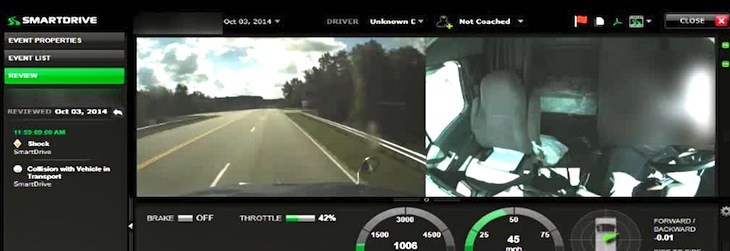Carriers shy away from driver-facing cameras, don’t want ‘big brother’ atmosphere
by February 15, 2017 2:48 pm 5,907 views

Part of an image from the in-cab system provided by SmartDrive.
While some company fleets have been testing in-cab cameras that face drivers, most large carriers in the state either don’t plan to use the systems or declined to talk about them. Privacy remains the biggest concern with their use.
In many cases, “companies are apprehensive” because of the privacy issue, said David O’Neal, director of safety services for Arkansas Trucking Association. There use might be viewed as a “big brother type atmosphere. I think that’s probably the biggest issue,” a driver-facing camera “right there on you every moment of the day.”
But Bentonville-based Wal-Mart Stores and Memphis-based FedEx have been looking at them. Wal-Mart uses and tests technology “to make our logistics network, a core strength for the company, safer and even more efficient,” company spokesman Scott Markley said. This “is just one of many pilots to learn how we can be even better.” In a similar statement, FedEx Freight looks at “technology that will better ensure the safety of our team members and the motoring public.”
ArcBest Corp., a Fort Smith-based transportation company, plans to have “collision mitigation systems with either forward-facing cameras and/or forward-looking radar” on the trucks it will purchase in the future, spokeswoman Kathy Fieweger said. “At this time, we do not plan on purchasing tractors with cab-facing cameras.”
While the trucking association doesn’t have a specific stance on in-cab cameras, there are other cameras aside from the driver-facing camera that carriers have been using. Some in-cab cameras face toward the front of the truck, not monitoring the driver but capturing the road ahead. There are also external cameras that can be used in conjunction with in the in-cab cameras to help determine liability if the truck is involved in a crash.
Generally, most camera systems are always recording, but the video is typically not saved unless an incident happens that triggers the video to start being saved, O’Neal said. A triggering event, such as a crash, sudden turn of the steering wheel or hard braking, would cause the camera to save the video about 10 seconds before the event and 10 seconds after it ends. The video that’s saved in a triggering event could be reviewed by the trucking company, but some camera system suppliers review the video before determining whether to notify the carrier based on the cause of the trigger. This “full package service” would have the supplier monitor the system instead of the carrier, O’Neal said.
One of the top brands offering these systems, San Diego-based SmartDrive Systems, recently reported 94% “organic subscription growth” in 2016, compared to 2015 and almost 400% growth over three years. While some suppliers are “trying to gain a foothold in the market with low cost, no-review services,” fleets are opting for “full-service programs” to “identify risk, improve driver performance and save their teams’ time versus requiring them to hire more headcount to become video reviewers,” according to a company news release.
“What gives use the greatest satisfaction is knowing how many drivers avoided collisions that didn’t have to happen, how many lives were saved as a result and how many drivers’ jobs were protected based on clear and accurate information about what occurred on the road,” SmartDrive CEO Steve Mitgang said in the release.
Another top brand, Lytx, which is also based in San Diego, provides the company’s DriveCam program to more than 650,000 commercial and government fleet drivers.
RISK AND REWARD
Attorney James Franklin, who works in litigation, transportation, distribution and logistics and personal injury groups, wrote that some suppliers “offer affirmative coaching for drivers seen as demonstrating risky driving behavior.” Also, carriers could use data gathered by the systems “as a teaching tool to reduce the likelihood of future accidents.”
The main purpose of the camera systems is “to promote safety,” O’Neal said. They would do this by encouraging the driver to operate the vehicle safely, and they could be used to determine fault in a crash.
But one concern with using the systems is if a carrier were sued as a result of a crash involving one of the company’s trucks and driver, and the video that was recorded would likely be required to be turned over to the complainant, Franklin wrote.
“Even more terrifying are the potential consequences involving any report rendered by the vendor. The default rule in litigation is that a third party’s involvement probably waives the protections otherwise afforded to confidential material between the transportation company and its attorney,” he noted.
Because the court might see the supplier or vendor as a third party, “a court may force the company to turn over the recording and the report,” which might lead to more damaging information against the company or driver in question. Companies also should be aware of the costs related to the systems, and the laws that might restrict their use. Carriers that understand and address the risks associated with using the systems may “completely recognize and profit from the significant benefits offered by on-board video camera technology,” Franklin said.
As an estimate, each system costs less than $1,000 per truck, and a monthly fee of $25-$30 per truck might be required. But this could change based on order volume, O’Neal said. Camera systems have been available for about 10 years, and started becoming more commonplace in the past five years.
